How to Climb Alpine AD
This is a fun and big Alpine grade which normally has a bit of everything; snow, ice and rock climbing adventure. Having the ability to operate at this grade broadens your options and opens the door to most of the big mountains in the Alps.
Ascent and descent of AD routes can be adventurous and wild, demanding efficient movement and pace in order to have an event-free experience. Most Alpine techniques will be incorporated on an AD route and you need to be comfortable in them to be able to progress from PD.
Alpine techniques such as moving together, pitched climbing, short pitches, abseiling and down-climbing will all be involved. Often routes are a mix of snow/ ice and rock, so crampons and an ice axe will need to be carried depending on the route. It is a great grade to achieve to allow you to access some truly inspiring parts of the Alps.
Your alpine techniques and rock-climbing skills should be well practiced and automatic before you attempt your Alpine AD. This is not really the grade, or terrain to learn new skills for the first time. I know these may sound like high standards but if you rock climb regularly, scramble and winter climb throughout the UK, then all the mentioned skills and techniques are already tried and tested.
.
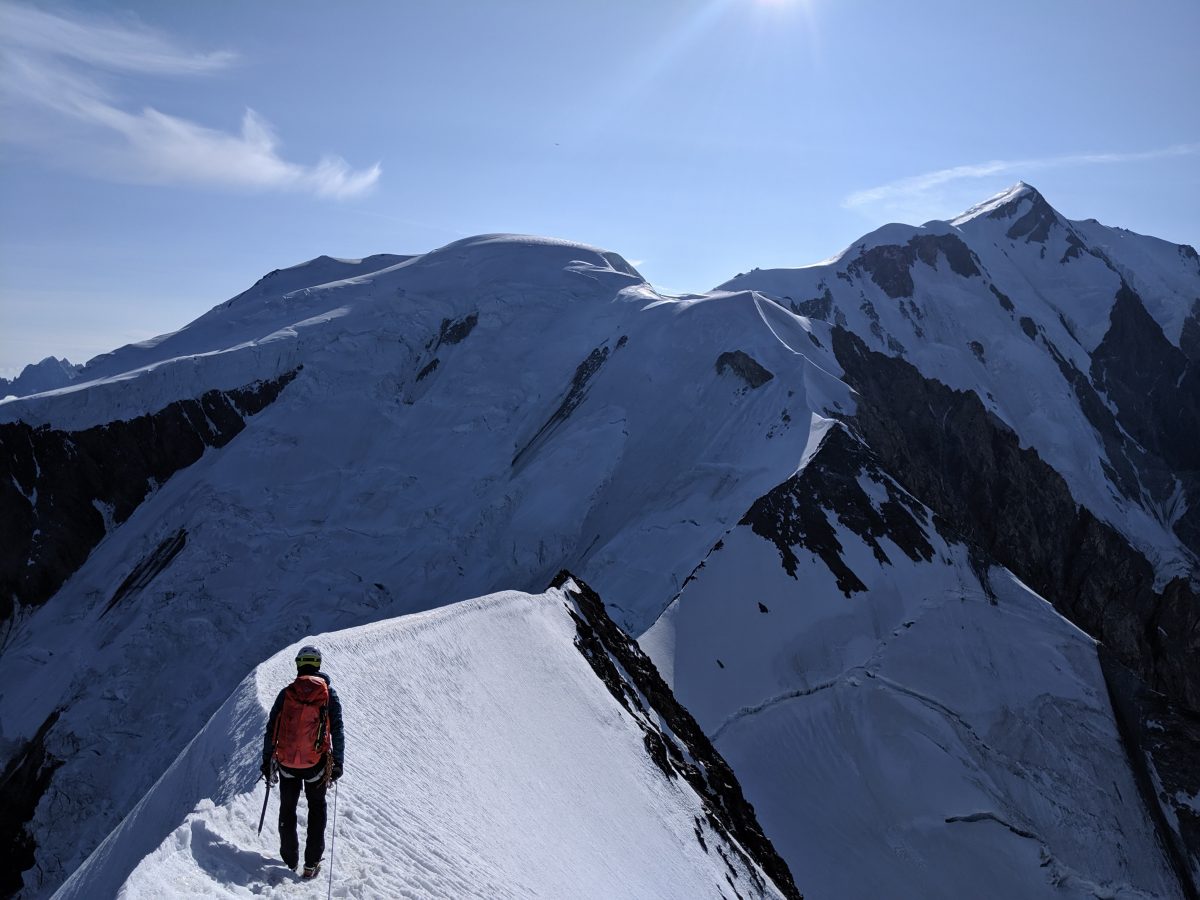
.
Your first AD
Try and aim for an AD that isn’t too long and is in good condition for the time of year. Do your home work, planning is essential. Guidebooks are excellent now and many of them offer selected classic routes for a particular area, including a lot of classic well-travelled Alpine AD routes. What you will find with this grade is that there is a range of styles and types and to help you interpret this better, many guidebooks give you a description between an AD+ or sometimes AD-. The guidebook time is also a good indicator of what to expect and how difficult the route might be.
In the summer mountain routes can suffer from extremes of temperature. Try to ensure that you are on the right route and have the necessary conditions. Some require good snow and ice, but if it has been extremely hot for a few weeks, this may be lacking and rock fall could be a hazard. What are the optimum conditions for your chosen route? This risk assessment principle applies to most mountain routes and your decision making.
Where?
You pick your adventure, and how big that adventure will be. Some places are more remote than others and subsequently have less infrastructure and information readily available.
Even in the popular areas like Chamonix you can find quiet mountains and have the whole route to yourself. However, when you are starting out, having other people around and being on a well-travelled route isn’t a bad thing. You learn lots by watching how others operate and it can feel safer initially with a couple of teams on the same route. In time you may choose to go more remote, and increase the adventure, but try not to rush this learning process and have fun.
.
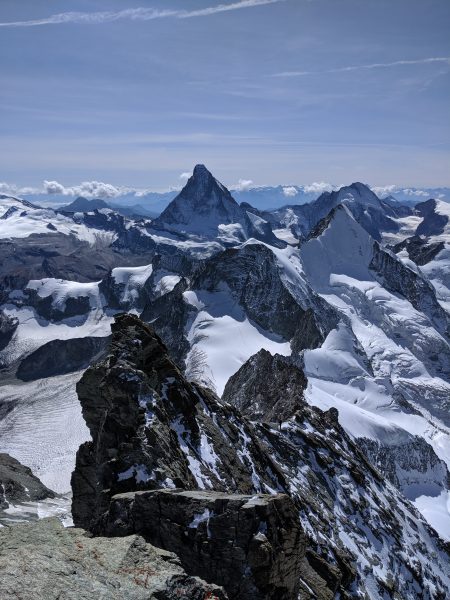
.
Equipment
You’ll need a go anywhere rack.
The rack is light and usable on the terrain you are likely to meet. It all starts with your go anywhere rack and you can add items if you feel you require more.
- 3 cams, suggested sizes 1, 2 and 3
- (Odds or even, whichever you prefer…I choose even) numbered set of wires – numbers 2,4,6,8,10
- 4 x quickdraws/extenders
- 4 x 120cm slings
- 4 x screw gates
- 2 x ice screws
- 1 x belay plate
- Crevasse rescue equipment
- 1x 50m single rope
This is a good starting point for planning what you may require and how much equipment to carry. Ultimately, you are making small compromises while trying to match the amount of rack to carry, to how much it will be required and used.
Beyond the usual Alpine equipment, you may need extras depending on the style of route. For instance, extra ice axe and ice screws for a snow/ice route and more rock rack for a dedicated rock ridge/climb. This is the challenge and it is a great skill knowing what the right amount is to carry. It’s fun learning, but doesn’t happen straight away.
.
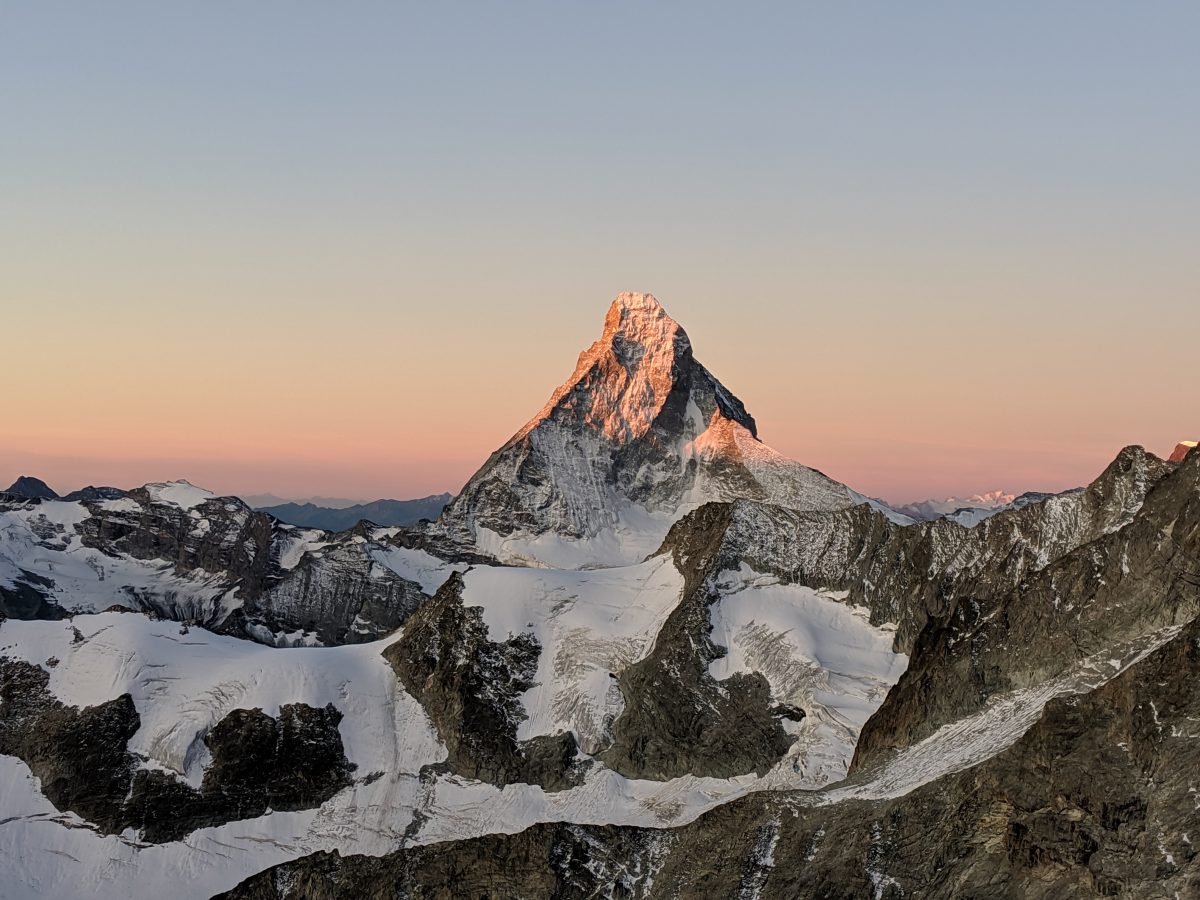
.
Alpine techniques required
.
AD climbs involve everything that you may have experienced on your PD and PD+ terrain, just more of it. Expect harder rock climbing and more involved abseils, and subsequently more pitched climbing and a greater need for efficient transitions between easier terrain. On longer AD routes it is likely you will have to move together on the easier sections in order to keep time. Ensure this technique is well practiced and protected.
Rope systems
Moving as a roped climbing team when the terrain doesn’t require a climbing pitch is a real challenge and demands respect and carries great consequences. Done correctly, the team can move well together, roped up over easy terrain.
Walking/easy ground
Starting out, the terrain may be resemble walking ground or terrain where the rope isn’t really needed for a period of time. One of the difficult things in the Alps is that for most of the day we have the rope on. The challenge is to do this without it impeding on the day and making movement laboured and complicated. When walking or carrying the rope between the team when there is no risk of a slip or a fall, in this case the rope can be hand coiled by both climbers, or by the person in front for greater security and readiness.
Short pitch, terrain belaying
When the terrain ahead is no longer walking ground, two hands maybe required for short steeper sections of rock or snow. A little quick pitch can then be employed with a simple efficient belay to reflect the size and difficulty of the step. Often this might be the terrain around you, a good spike or good friction over rock shaped. Sharp edges must be avoided and if it is steep climbing you might consider a normal climbing belay.
Long pitch
A ‘long pitch’ is when the terrain ahead of you is steeper and longer than the rope you have already set up. It may be that you need to drop some coils and make a belay for your second. The terrain could be rock or snow/ice, but no longer feels like a short pitch. Techniques now draw back to your conventional climbing or ice climbing pitch. It would be normal also to have a lead belay and place runners for protection and operate a climbing belay at the top. The principle again is reflecting the seriousness and difficulty of rope management systems and techniques.
This is where your rock-climbing skills and practice will pay off, helping you to operate efficiently and safely.
.
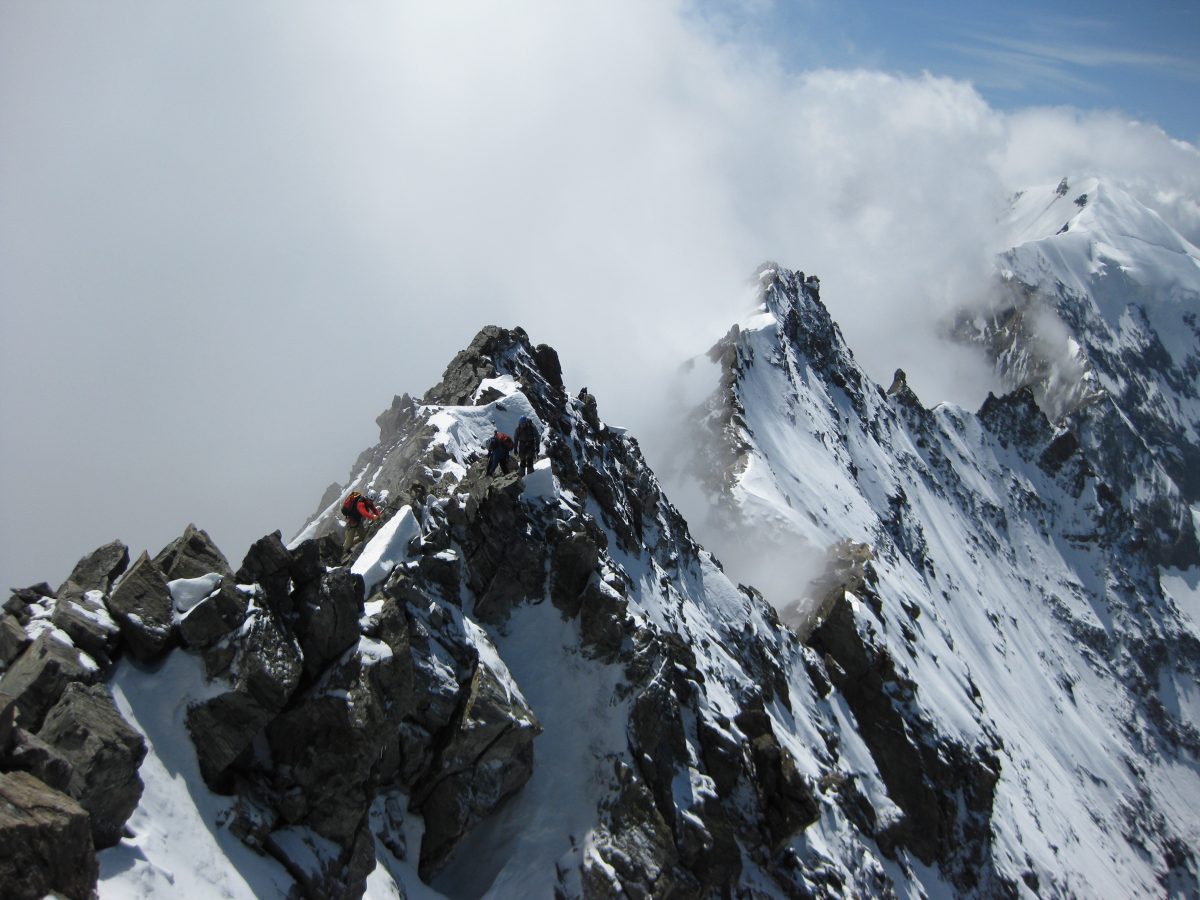
.
Moving together
‘Moving together’ is an advanced technique and demands respect and good judgement of the terrain. It is important that both leader and second understand the situation and are moving well. It involves both climbers moving, scrambling and climbing while at the same time attached to the rope and with gear in the mountain for protection.
Good teamwork and practice is required to successfully accomplish this technique. It’s also important that you understand the principles and why you are doing it. Done incorrectly or badly can have serious consequences. The key is to place enough gear and be on appropriate terrain that is not too difficult.
This rope system can be used on terrain that isn’t easy but is also not hard for either the leader or the second. It is used to cover terrain efficiently when time is an issue and the length of the route demands good pace. Ensure the rope length is far enough apart to give time and opportunity for runner protection and terrain options to move the rope around, maximising your protection.
If at any point both climbers feel the terrain is too difficult, a belay can be made and you can resort to a climbing pitch, with only one climber moving at a time. An insight to the terrain ahead and communication between the climbers is important and over time you will build up the intuition needed.
.
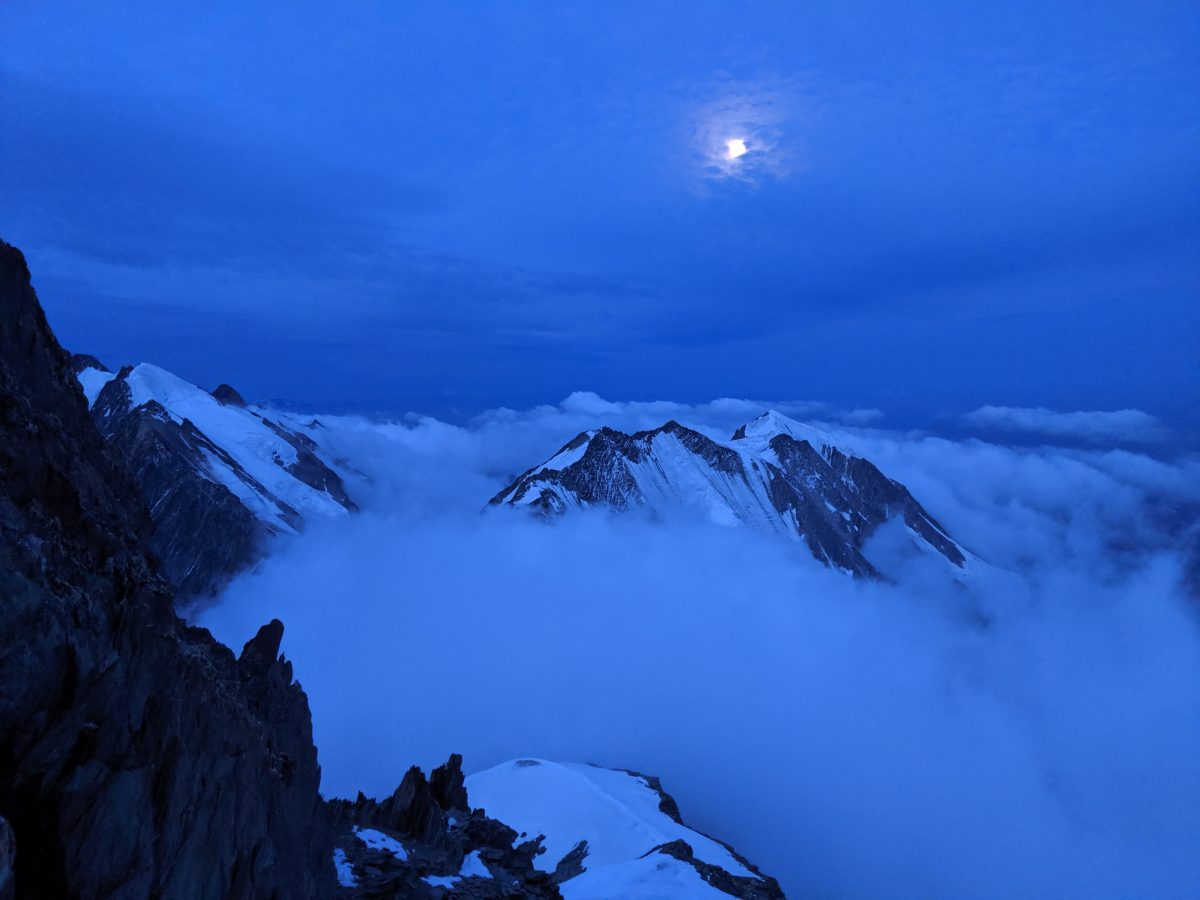
.
Descent -Downclimbing
A lot of the techniques we’ve looked at can be done in reverse and the same principles still apply. Downclimbing is normally more efficient on Alpine routes, if the terrain suits and the climbing is not too difficult. Downclimbing a section should be your first option as it is quicker, and less transition required. Greater care and time will be required for the last person to descend. Runners or gear can be placed by the first person to help protect or you may consider a quick back rope, or a spike used as intermediate protection for the last person down. The next option is to abseil, this often occurs at a recognised abseil station on popular alpine climbs.
Finding an easier descent than the AD you have climbed would be ideal, however sometimes this is not an option. The one benefit you have if you must descend your climb is that you will know the terrain well. In ascent remember key points and landmarks, this will give you greater insight to what lies ahead of you on your descent.
Abseiling
As mentioned above this occurs when downclimbing is too difficult and often when there is a recognised abseil point on the route. Usually in descent, but sometimes this will also be used as a technique to overcome a gendarme on the route.
Abseiling should be well practiced, and care taken not to rush as this is when accidents can happen. One way of speeding things up in a mountaineering situation is perhaps to lower your climbing partner first, then only one person is having to abseil. This is only an option when the abseil line is clear, and you can see where you are going to. If it is a multi-stage abseil or in a rock-climbing descent, then it is better for everyone to abseil.
Transitions
By transitions, I am refer to changes between rope techniques to reflect the terrain ahead or having to do an abseil. All of which can be time consuming. Try and think ahead and practice and reflect during easier situations and routes. Consider what the guidebook time is for the route, use this as a measure of your performance and rope system management etc.
Team work
Team work and a shared skill set is important and can make or break the whole trip. Try to be aware of each other’s strengths and weakness and work together. The more you climb as a team, intuition builds, this can speed up climbing situations and therefore be more fun for everyone. Alpine climbing can be stressful at times, so it’s important to remember to work as a team and share the efforts. Strong team spirit can lead to a successful and safe fun Alpine adventure.
The climbing involved and condition reports
At altitude rock pitches and terrain will feel harder, more like around the V.Diff to Severe rock grade at times. On a mountaineering style route, it may just feel like long scrambling, all of which will be climbed in your big boots. It’s a balance between the difficulty of the climbing and the length of the route as to whether you decide to carry rock boots – it’s normal to climb most AD terrain in your mountaineering boots. If your chosen AD is more of a snow and ice climb, you may have terrain similar and up to Scottish grade III. Remember though that snow and ice routes in the Alps can fall out of condition far more readily than rock ridges or rock climbs.
It’s important that you have appropriate weather and conditions for your chosen route. With recent Alpine summers getting warmer, it is more likely to be earlier and later in the season that the conditions will be suitable. Rock ridges and rock climbs in the mountains have become more dependable and reliable options. Be sure to monitor conditions and listen to advice that is available. Social media (carefully selected!), local guides offices, mountain huts/guardians and IFMGA mountain guides can be a good source of current information and conditions.
Operating in the Alps offers an amazing experience, full of adventures and learning experiences. Look for progressions and ambitions that suit you and your team, work together and have fun exploring.
The challenge is moving well and safely. Keep practicing your skills in the UK and enjoy planning your next Alpine adventure.
.
.
Catch up on Stuart’s The North Faces of the Alps series:
Six North Faces: Aiguille du Dru
Six North Faces: Grandes Jorasses
.
.
.
About Stuart McAleese IFMGA Mountain Guide
.
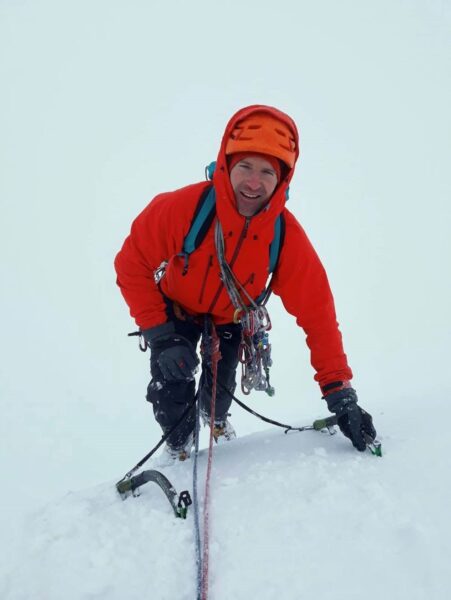
.
Originally from Northern Cumbria I started out hill walking in the Lake District when I was at school. I soon become interested in rock climbing and mountaineering, and was lucky enough to work and climb with Mountain Guides during my first job leaving school. Since then I’ve been working full time in the mountains for around 20 years.
At the same time as working, I enjoy climbing in my free time and have been lucky enough to go on many expeditions around the world, climbing new mountains, first ascents and tough remote summits. Places such as Patagonia, Alaska, Himalaya, Peru, Baffin Island, Yosemite and China. In 2004 I was nominated for the prestigious Piolet d’Or in Grenoble, France, for a 1st ascent of the ‘Supa Dupa Couloir’ in Alaska.
I love my job as a Mountain Guide, teaching and exploring big mountains in all weather all year round. I joined the Glenmore Lodge team in 2019 and head up the Summer Alpine programme as well as delivering on the Rock & Mountain programme of training courses.